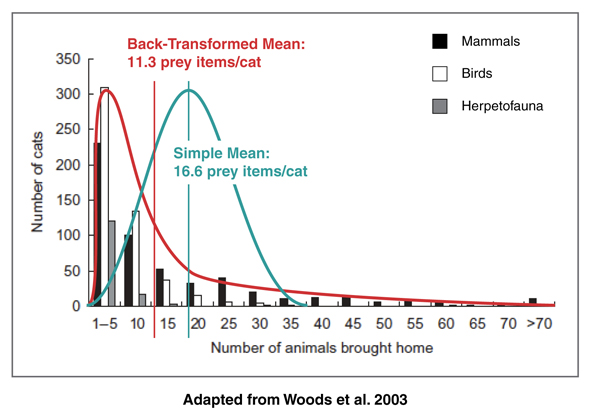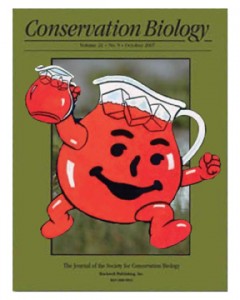Whether the latest iteration of reality TV— Animal Planet’s Confessions: Animal Hoarding—is more education, entertainment, or exploitation is a matter of debate. But it’s a safe bet that by streaming “an unflinchingly honest look at a human condition that affects people and animals” into living rooms across the country, a problem too rarely acknowledged (not to mention taken seriously) is now receiving unprecedented attention.
Even if I were a cable subscriber, though, I don’t think I’d be tuning in. Although I was nowhere near the “front lines” of the Great Kitty Rescue, I’ve seen and heard plenty where animal hoarding is concerned. But in reading about Confessions, I was reminded of some remarks included in a comment published earlier this year in Conservation Biology. There, Christopher Lepczyk, Nico Dauphiné, David M. Bird, Sheila Conant, Robert J. Cooper, David C. Duffy, Pamela Jo Hatley, Peter P. Marra, Elizabeth Stone, and Stanley A. Temple compared TNR to animal hoarding:
“The animal welfare community opposes ‘cat hoarding,’ whereby people care for more pets than they can adequately support, because it is considered inhumane. Trap-neuter-return is essentially cat hoarding without walls. Considering that most communities have laws banning animal hoarding, we should consider the same standard for outdoor cats as those that are in a person’s home.” [1]
This strikes me as almost desperate—the latest volley in the kitchen-sink/something-for-everybody approach taken by some TNR opponents. Nevertheless, the analogy—however incongruous—is not new. In 2004, David Jessup made essentially the same comparison:
“Some people are compelled to own and care for excessive numbers of cats. This psychological illness is referred to as ‘collectors psychosis.’ How is the person who must save 25 to 30 cats in their home different from the person who sees themselves [sic] as the savior of 25 to 30 cats in a park? Some ‘cat people’ may be ‘collectors,’ and it is possible that TNR is enabling and supporting some people who need psychologic counseling and assistance.” [2]
Jessup doesn’t burden himself or his audience with even the slightest support for his assertions; his claims are as much conjecture as anything else, his question largely rhetorical. Five years later, Dauphiné and Cooper revisited Jessup’s query, but—despite a handful of references—do no better in terms of its resolution:
“In many cases, the characteristics and behavior of people involved in TNR are suggestive of the psychiatric disorders described in problematic animal hoarding [3]. When presented with alternatives to TNR, such as enclosed sanctuaries, no-kill shelters, and traditional animal control, many such people can be “fiercely protective, retaliatory, and uncooperative,” [4] and will subject public officials and other citizens opposing TNR to harassment and threats [5, 6].” [7]
Animal Hoarding
Dauphiné and Cooper’s argument presupposes that enough is known both about “people involved in TNR” and “the psychiatric disorders described in problematic animal hoarding” for a valid comparison to be made. In fact, very little is known about either one. Randy Frost, whose 2000 article the authors cite, begins by noting, “almost no psychiatric literature exists on this topic.” [3] A year earlier, Gary Patronek (a collaborator of Frost’s, whose work Frost cites throughout his paper) observed: “Unlike the hoarding of inanimate objects, which may be linked with a variety of psychiatric conditions, animal hoarding has not yet been linked with any specific disorder.” [8]
Nevertheless, both Patronek and Frost describe—based on some of the earliest research on the subject—some common characteristics of, and explanatory models for animal hoarding. And provide this definition:
“someone who accumulates a large number of animals; fails to provide minimal standards of nutrition, sanitation and veterinary care; and fails to act on the deteriorating condition of the animals (including disease, starvation and even death) or the environment (severe overcrowding, extremely unsanitary conditions), or the negative effect of the collection on their own health and well-being and on that of other household members.” [8]
This seems to have been the framework for the definition adopted by the Hoarding of Animals Research Consortium (with which Patronek and Frost were involved), which places greater emphasis on two key elements: denial, and accumulation and control:
- Having more than the typical number of companion animals;
- Failing to provide even minimal standards of nutrition, sanitation, shelter, and veterinary care, with this neglect often resulting in illness and death from starvation, spread of infectious disease, and untreated injury or medical condition;
- Denial of the inability to provide this minimum care and the impact of that failure on the animals, the household, and human occupants of the dwelling;
- Persistence, despite this failure, in accumulating and controlling animals.
“Saving” 25 or 30 cats, then—whether in one’s home or in the park—does not constitute animal hoarding. As Patronek pointed out during a recent interview on NPR’s Radio Times, “numbers alone don’t define hoarding… you’ve got to have these functional deficits and denial, in combination with the numbers.”
Opponents of TNR (and of free-roaming cats in general) will likely seize upon that second point, arguing that feral cat colonies—by definition—lack adequate care. But the very fact that these cats are part of a TNR program means they’ve been evaluated by veterinary professionals, requiring a concerted effort—sometimes bordering on the heroic—on the part of the trappers and caregivers involved. Some programs perform vaccinations (that this is not standard practice, is, admittedly, a controversial issue); at a minimum, cats deemed too sick to be returned are euthanized.
A 1999 survey of survey of “101 individuals or couples who cared for 132 colonies of free-roaming cats in north central Florida” illustrates the importance caregivers place on health:
“More than a third of the caretakers reported that they had provided some kind of veterinary care (not including being neutered at the TNR clinic) for the cats in the past or would provide veterinary care if it was necessary in the future. This type of care included booster vaccinations, parasite control, antibiotic treatment, ear medication, veterinary examinations, and emergency treatment.” [9]
In addition, 96% provided food, and 75% provided shelter. It’s important to note, too, that these numbers are conservative relative to the care received by the cats, in that (1) some caregivers were responsible for multiple cats, and (2) respondents to the survey were not necessarily the individuals who provided food, shelter, and so forth.
Such findings are certainly consistent with my own experience. The TNR networks I’m tapped into (mostly by way of e-mail or online bulletin boards) are typically buzzing with requests from, and recommendations to, caregivers committed to maintaining and improving the health of feral cat colonies.
On the other hand, it’s not clear from Dauphiné and Cooper’s paper that their reference to animal hoarding has anything to do with the behavior’s defining characteristics at all. More than anything else, the authors seem to be suggesting that resistance to TNR “alternatives” constitutes some psychiatric disorder—a possible reference to animal hoarders’ “reluctance to remove any animals, even when adequate homes were available.” [3]
Alternatives to TNR
Respectable sanctuaries, as I’ve already discussed, are few and far between, and typically at operating at capacity. In any case, such environments are not in the best interest of unsocialized cats. No-kill shelters, too, are scarce, and—recognizing realities Dauphiné and Cooper (and veterinarian Christine Storts, whose letter they cite) overlook or ignore—generally endorse TNR as their feral cat management approach. [10]
And as for “traditional animal control,” that’s nothing more than a rather cowardly euphemism for trap-and-kill.
What about the harassment and threats? Here, Dauphiné and Cooper cite Paul Barrows’ 2004 article “Professional, Ethical, and Legal Dilemmas of Trap-Neuter-Release,” and Pamela Jo Hatley’s 2004 paper, “Will Feral Cats Silence Spring in Your Town?” “During the past several years,” writes Barrows:
“as debate regarding abandoned and feral cats has become more heated, concerns have emerged regarding the extent to which some activists will go to promote their cause. Those supporting trap and removal of abandoned and feral cats, rather than TNR, have reported verbal abuse, personal threats, disruption of public forums, and interference with the conduction of their businesses.” [5]
Dauphiné and Cooper buy into Barrows’ account without bothering to check out his source (actually, these two make a shameful habit of such shortcuts throughout their paper, thereby raising questions about their numerous assertions, and, more problematically, their capabilities and integrity as researchers). In fact, Barrows cites a 2002 Wall Street Journal story in which exactly one of “those supporting trap and removal”—Frank Spiecker, of Garden State Pest Management—was interviewed:
“…property managers, fearing health complaints or lawsuits, hire Mr. Spiecker to trap and remove stray cats… Cat jobs have gotten him screamed at, threatened and jostled. His truck has been jumped on and pounded, his traps run over, and his trapped cats freed… To cat lovers, he abets feline mass murder, since most of the cats he traps end up dead.” [11]
All of which seems remarkably flimsy for describing and condemning—as Dauphiné and Cooper do—the behaviors of “many such people.” Until it’s compared to the even flimsier “evidence” provided by Hatley:
“Many citizens and public officials have voiced concerns about the public health issues and wildlife issues involved in hoarding large numbers of cats in the wild. Some who have resisted the extreme efforts by proponents of TNR and cat colonies have been subjected to verbal abuse and threats.” [6]
Dodgy research practices aside, the notion that one’s preference for TNR over “enclosed sanctuaries, no-kill shelters, and traditional animal control” is indicative of some psychiatric disorder remains a mighty hard sell. Dauphiné and Cooper’s so-called alternatives are simply not—in a very literal sense—viable options.
* * *
To compare TNR to animal hoarding betrays either a profound lack of knowledge about either one, or a desperate attempt to taint the former by association with the latter. I suspect that, like the most despicable political strategists, Jessup, Dauphiné and Cooper, and Lepczyk et al., threw it out there just to see if it would stick—the connection they’re attempting to make certainly has nothing to do with science.
I’ve a friend who jokes that the only thing feral cats aren’t being blamed for these days is climate change. Well, not yet, anyhow.
Literature Cited
1. Lepczyk, C.A., et al., “What Conservation Biologists Can Do to Counter Trap-Neuter-Return: Response to Longcore et al.” Conservation Biology. 2010. 24(2): p. 627-629.
2. Jessup, D.A., “The welfare of feral cats and wildlife.” Journal of the American Veterinary Medical Association. 2004. 225(9): p. 1377-1383.
3. Frost, R., “People Who Hoard Animals.” Psychiatric Times. 2000. 17(4).
4. Storts, C.M., “Discussion on TNR programs continue (letter).” Journal of the American Veterinary Medical Association. 2003. 222: p. 711–712.
5. Barrows, P.L., “Professional, ethical, and legal dilemmas of trap-neuter-release.” Journal of the American Veterinary Medical Association. 2004. 225(9): p. 1365-1369.
6. Hatley, P.J. (2004) Will Feral Cats Silence Spring in Your Town? www.pamelajohatley.com/Articles/ABA.pdf Accessed August 8, 2010.
7. Dauphiné, N. and Cooper, R.J., Impacts of Free-ranging Domestic Cats (Felis catus) on birds in the United States: A review of recent research with conservation and management recommendations, in Fourth International Partners in Flight Conference: Tundra to Tropics. 2009. p. 205–219.
8. Patronek, G.J., “Hoarding of animals: An under-recognized public health problem in a difficult-to-study population.” Public Health Reports. 1999. 114(1): p. 81–87.
9. Centonze, L.A. and Levy, J.K., “Characteristics of free-roaming cats and their caretakers.” Journal of the American Veterinary Medical Association. 2002. 220(11): p. 1627-1633.
10. Winograd, N.J., Redemption: The myth of pet overpopulation and the no kill revolution in America. 2007: Almaden Books.
11. Sterba, J.P., Tooth and Claw: Kill Kitty?, in Wall Street Journal. 2002: New York. p. A.1


